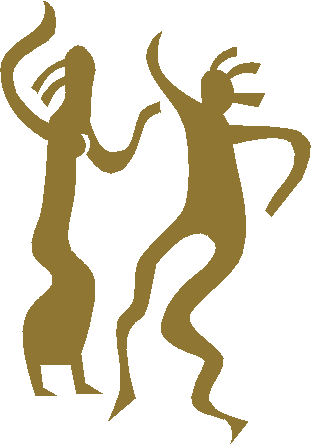ROOTS
OF DANCE  Dancing is one of the most primitive instincts of mankind, older than any
of man’s activities but for eating, drinking and love. Dancing is one of the most primitive instincts of mankind, older than any
of man’s activities but for eating, drinking and love.
Rhythm is the basis of dance.
Rhythm is Life, older than man and any of his activities. Rhythm forms the basis of all of
man’s activities, from his need to eat, drink, sleep, breathe, move. It is as old as
day and night and the seasons.
Emotion stimulates the body into
movement. Even while civilization and conditioning have taught people to suppress this
natural response, the primitive desire is still waiting to be tapped.
Long before man was able to
verbalize his thoughts and desires through speech, he communicated with his fellow man
through signs and body movement, as proven by primitive cave-drawings depicting people
dancing.
As language was developed,
the early man’s expressive movements continued, however these ceased to be
spontaneous. They were later adapted as part of the customs of the tribe and though often
their origins were forgotten, the dances lived on and became the foundation of folk
dances.
Dance master Victor
Silvester, in his book Modern Ballroom Dancing, declared: “The desire to move in
response to emotion is a physiological fact which will survive, no matter how it may be
suppressed, as long as people exist. The persistence of rhythm and its intimate
association with sex and life itself is undeniable, and when rhythm and movement come
together, dance is born.
“It is doubtless this
desire for rhythmic movement combined with communal instinct which is innate in
almost every human being that enabled these crude folk dances to survive that dull period
of history known as the Dark Ages.”
“Throughout these earlier dark
and middle ages”, writes Mr. Perugini in his Pagaent of the Dance and Ballet, “dancing
itself was always to be found in every country, in the form of traditional folk or
national dances, indigenous to the soil: and moreover, dancing was a regular feature of
most of the Church festival days, especially in Italy, France and England. The dance may
have languished during those dark and or early middle ages, but it certainly did not die.
What the dances of that lengthy period were -- roughly from the dawn of the
Christian Era to the fourteenth century -- we do not know, or less surely at any rate than
we do those of ancient Greece, simply from lack of those pictorial representations in
which the Hellenic period of the dance was so rich. Indeed it is not really until the
fifteenth century that we begin to find reliable records of the actual dances then in
vogue, or any considerable testimony as to the popularity of dancing save in the form of
ecclesiastical permission, or proscription.”
Modern man’s
first authoritative glimpse into the earliest ballroom dances came from a French priest,
writing under the name of Thoinot-Arbeau in 1588 through his book Orchesographie. From him
we are able to gather that a very solemn base danse held sway for a long time but that at
the time of his book, was then being taken over by the livelier branle. The branle
was a generic dance form though each French province had its own brand. The Gavotte for
instance came from Provence and danced originally by the inhabitants of Gap. The Minuet,
on the other hand, was a branle of Poitou.
The Minuet was introduced into
the court of Paris in 1650, and dominated the ballroom until the close of the 18th
century. Even the ballets of the time consisted of Minuets as entrees.
The Waltz was first noticed in
the year 1780, and is widely believed to have come from the Lšndler of Southern
Germany. After additions and ‘considerable improvement on its primitive
principles’, the Waltz became a most fashionable dance in the courts of Europe.
In those days however, the Waltz
was danced with the partners holding each other only by the hands. However in 1812,
the modern dance hold was introduced in England, which elicited so much
opposition from the very conservative social circles. It was surely the first time that
the man put his arm around his partner’s waist and held her so close to him to
dance.
‘No event ever produced so great a sensation in English Society as the introduction
of the German Waltz’, says a writer of the period. ‘The Anti-Waltzing party took
the alarm, cried it down, mothers forbade it, and every ballroom became a scene of feud
and contention, sarcastic remarks flew about, and pasquinades were written to deter young
ladies from such a recreation’.
This uproar finally died only
when n the Emperor Alexander of Russia was seen waltzing at the highly exclusive assembly
room, using the modern hold.
By 1840, new dances made their
appearance in the ballroom. These included the Polka, Mazurka, and the Schottische.

|
